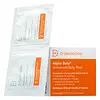What's inside
What's inside
 Key Ingredients
Key Ingredients

 Benefits
Benefits

 Concerns
Concerns

 Ingredients Side-by-side
Ingredients Side-by-side

Water
Skin ConditioningAlcohol Denat.
AntimicrobialGlycolic Acid
BufferingPotassium Hydroxide
BufferingHamamelis Virginiana Water
AstringentSalicylic Acid
MaskingPolysorbate 20
EmulsifyingCitric Acid
BufferingLactic Acid
BufferingMalic Acid
BufferingCamellia Sinensis Leaf Extract
AntimicrobialAchillea Millefolium Extract
CleansingAnthemis Nobilis Flower Extract
MaskingSoy Isoflavones
Skin ConditioningCopper PCA
HumectantZinc PCA
HumectantLecithin
EmollientDisodium EDTA
Alcohol
AntimicrobialPolysorbate 80
EmulsifyingParfum
MaskingLinalool
PerfumingBenzyl Salicylate
PerfumingBenzoic Acid
MaskingPhenoxyethanol
PreservativeSodium Benzoate
MaskingSodium Bicarbonate
AbrasiveAscorbic Acid
AntioxidantAscorbyl Palmitate
AntioxidantRetinyl Palmitate
Skin ConditioningRetinol
Skin ConditioningTocopheryl Acetate
AntioxidantResveratrol
AntioxidantUbiquinone
AntioxidantLeuconostoc/Radish Root Ferment Filtrate
AntimicrobialPhospholipids
Skin ConditioningSodium PCA
HumectantDimethicone
EmollientPEG-30 Stearate
EmulsifyingOctoxynol-9
EmulsifyingBHT
AntioxidantTetrasodium EDTA
Sorbic Acid
PreservativeWater, Alcohol Denat., Glycolic Acid, Potassium Hydroxide, Hamamelis Virginiana Water, Salicylic Acid, Polysorbate 20, Citric Acid, Lactic Acid, Malic Acid, Camellia Sinensis Leaf Extract, Achillea Millefolium Extract, Anthemis Nobilis Flower Extract, Soy Isoflavones, Copper PCA, Zinc PCA, Lecithin, Disodium EDTA, Alcohol, Polysorbate 80, Parfum, Linalool, Benzyl Salicylate, Benzoic Acid, Phenoxyethanol, Sodium Benzoate, Sodium Bicarbonate, Ascorbic Acid, Ascorbyl Palmitate, Retinyl Palmitate, Retinol, Tocopheryl Acetate, Resveratrol, Ubiquinone, Leuconostoc/Radish Root Ferment Filtrate, Phospholipids, Sodium PCA, Dimethicone, PEG-30 Stearate, Octoxynol-9, BHT, Tetrasodium EDTA, Sorbic Acid
Water
Skin ConditioningGlycolic Acid
BufferingCyclodextrin
AbsorbentCaprylic/Capric Triglyceride
MaskingDimethicone
EmollientGlyceryl Stearate
EmollientSucrose Stearate
EmollientSodium Hydroxide
BufferingGlycerin
HumectantPhenoxyethanol
PreservativeLespedeza Capitata Flower/Leaf/Stem Extract
Skin ConditioningPropanediol
SolventXanthan Gum
EmulsifyingEthylhexylglycerin
Skin ConditioningHydroxyethyl Acrylate/Sodium Acryloyldimethyl Taurate Copolymer
Emulsion StabilisingPolysorbate 60
EmulsifyingSorbitan Isostearate
EmulsifyingWater, Glycolic Acid, Cyclodextrin, Caprylic/Capric Triglyceride, Dimethicone, Glyceryl Stearate, Sucrose Stearate, Sodium Hydroxide, Glycerin, Phenoxyethanol, Lespedeza Capitata Flower/Leaf/Stem Extract, Propanediol, Xanthan Gum, Ethylhexylglycerin, Hydroxyethyl Acrylate/Sodium Acryloyldimethyl Taurate Copolymer, Polysorbate 60, Sorbitan Isostearate
 Reviews
Reviews

Ingredients Explained
These ingredients are found in both products.
Ingredients higher up in an ingredient list are typically present in a larger amount.
Dimethicone is a type of synthetic silicone created from natural materials such as quartz.
What it does:
Dimethicone comes in different viscosities:
Depending on the viscosity, dimethicone has different properties.
Ingredients lists don't always show which type is used, so we recommend reaching out to the brand if you have questions about the viscosity.
This ingredient is unlikely to cause irritation because it does not get absorbed into skin. However, people with silicone allergies should be careful about using this ingredient.
Note: Dimethicone may contribute to pilling. This is because it is not oil or water soluble, so pilling may occur when layered with products. When mixed with heavy oils in a formula, the outcome is also quite greasy.
Learn more about DimethiconeGlycolic Acid is arguably the most famous alpha hydroxy acid (AHA) with tons of research backing its benefits.
It is found naturally in sugar cane but the form used in skincare is usually synthetic for purity and stability.
Glycolic acid removes the top layer of dead skin cells to allow newer and fresher ones to emerge.
AHAs work by breaking down the structural “glue” that holds old skin cells in place. When that buildup is gone, your skin can renew itself more efficiently.
Research also shows glycolic acid stimulates collagen production, helping to firm and thicken the skin over time. This is one of its biggest advantages over other AHAs.
Overall, glycolic acid helps with:
Fun fact: Glycolic acid boosts skin hydration by helping it produce molecules that increase hyaluronic acid naturally.
To work best, glycolic acid products should have a pH between 3-4 (that’s where exfoliation is most effective but still gentle on skin).
The pH and concentration of a product are key to its effectiveness:
It is normal to feel a slight stinging sensation when using glycolic acid. This usually fades as your skin adjusts.
Because glycolic acid has the smallest molecular size in the AHA family, it can penetrate deeper, which enhances its effectiveness but also makes it more likely to irritate sensitive skin.
If your skin is very sensitive or prone to rosacea, glycolic acid may be too strong; in that case, try milder options like lactic acid or a PHA instead.
Recent studies suggest glycolic acid might even help protect against UV damage. But don’t skip sunscreen! Freshly exfoliated skin is more sensitive to the sun.
Glycolic acid is a skincare superstar. It smooths, brightens, hydrates, and firms the skin. Unless you’re highly sensitive, it’s well worth adding to your routine.
Read more about some other popular AHA's here:
Learn more about Glycolic AcidPhenoxyethanol is a preservative that has germicide, antimicrobial, and aromatic properties. Studies show that phenoxyethanol can prevent microbial growth. By itself, it has a scent that is similar to that of a rose.
It's often used in formulations along with Caprylyl Glycol to preserve the shelf life of products.
Water. It's the most common cosmetic ingredient of all. You'll usually see it at the top of ingredient lists, meaning that it makes up the largest part of the product.
So why is it so popular? Water most often acts as a solvent - this means that it helps dissolve other ingredients into the formulation.
You'll also recognize water as that liquid we all need to stay alive. If you see this, drink a glass of water. Stay hydrated!
Learn more about Water